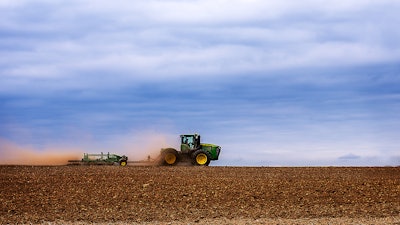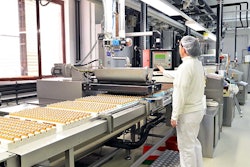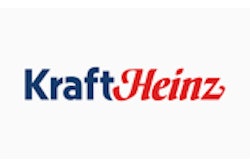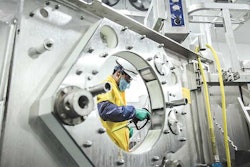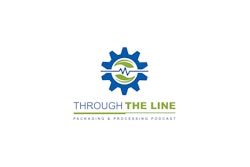For the past four years, the Wall Street Journal has brought together a who's who of the biggest names in food for its Global Food Forum. Companies like Campbell’s, McDonald’s, Panera, Hershey and Mondelez are just some of the companies that take the forum’s stage to explore key risks and opportunities shaping the global business of food.
TOM: Glen and I have been at the Forum now for about three years and we find each year it becomes a little more interesting. Some of the sessions are very specific to packaging and some of them a bit far, but certainly within the whole of the food chain.
GLEN: We’ve tried to pick out what is of interest to our members. Some of it has to do specifically with farming and agriculture and things that are a little far afield for us, but definitely there are takeaways that are pertinent to all up and down our supply chain.
The forum really concentrates on the global business of food, and they concentrate a lot on feeding a growing population and the challenges that will be faced by agriculture and packaging and processing all up and down. But certainly, sustainability was a big part of that. How do you get the food to where it needs to be? How do you prevent spoilage? But the real thing that I think was most interesting, from a member perspective, is the absolute pace of change. The consumer wants what they want, and they want it at a rapidly evolving rate that makes it difficult for all suppliers to react.
One of the statistics that was cited was that of 65 categories in your average grocery store, for 62 of them the category leader is losing market share. So, there are all these product innovations and packaging innovations. It’s incredibly difficult, for the big CPGs in particular, to react quickly enough to meet the consumer demands.
TOM: There was also a comment about the rapid change which was about the diversity of the consumer base. It’s not just the diversity that we hear among whether you are looking for a healthy snack or an indulgent snack, whether you are looking for an alternative to meat, or whether you are looking at a completely new diet approach, it’s both geographical and age-based. From the boomers, who are moving into later years of both their employment and now going into retirement to second careers, to what the Millennials are looking at is a different approach to the way that they eat, a different approach to what they are seeking in the marketplace.
GLEN: Snacking is a growing trend, and they’re saying younger generations are eating on average seven times a day. So, they’re trends are more towards smaller portions, more snacking. It’s a lifestyle choice. They are on the go, they are not sitting down for the traditional meals as earlier generations might have done. So, it definitely agile innovation—that’s a phrase that was used. But the thing that people don’t understand is the burden all up and down the supply chain.
Not only are they looking for smaller portion sizes, they are looking for healthy options. Often, they say one thing and do another. They’ll buy candy bars, they are still eating the things that aren’t healthy, that aren’t good for them. But the growing category is the healthy option, so I think you’re going to see more of that. But those types of products require certain types of packaging that might be different, and that’s the problem.
That pace of change burdens everything from the material supplier to the machinery supplier. One that was specifically noted is the ingredient supply. It is difficult to come up with things that have the right texture and the right taste—people want to eat healthy, but some of that stuff doesn’t taste as good as a candy bar. So, all up and down the supply chain are challenges. In order to able to react quickly enough and produce the product in the style and type of package that the consumer wants to have.
TOM: When you look for a replacement for a food to make it perhaps more healthy, you still need the same texture components in the foods so that the consumer that’s using it can understand or accept that it’s a similar product. I hadn’t thought about that. So you say, ‘ok we are going to replace ingredient x with ingredient y in addition to the supply chain issues’, you need to take a look at what that might be through not just the taste but the texture of the product you are offering to the consumer.
They also spoke about what they’re doing with their big data collection in agriculture. They used the example of a combine—and I don’t remember the exact number, but it’s hundreds of sensors that are on the combine—and then also began talking about the use of the data and how fine the data aggregation can be.
In some cases you could get that data down to almost a one foot-by-one foot area, if I remember the example. It was a pretty impressive display, realizing that you’re talking about thousands of acres, you’re looking at contours where there could be a slope to the area that’s been planted. I was thinking about that and had a chance to talk briefly about what that might mean, or what is similar to that for what we have with big data acquisition that are members are doing, and working with the CPGs, and found, interestingly enough, that some of the same issues apply.
One is that the amount of data that you can collect is enormous, and it’s less about the data collection and more about the data analytics. The other is that the companies are still addressing who controls that data, that is if you’re using the data to help the machine that’s out in the field do a better job of harvesting, or of planting, or of monitoring.
The last piece was the possibility of not just aggregating that data to make the better us of a machine or to make a better machine on the part of the supplier, but the last element was, what would be the possibilities of perhaps using that data to do some forecasting? Or to use some information with regards to the best crop rotation? Finding out that field benefits from a different crop rotation. Similarly, in packaging, when we have our members and the CPGs aggregating the data, is there information that can be gleamed from that relative to the changeover from product to product, and how effective that can be if we do a sequence, that is. Not specifically addressed at the conference, just a direct applicability to PMMI members and their solutions that they offer.
GLEN: I think we’d be remiss if we didn’t acknowledge the politics in this. I mean, the burden on the farmer is incredible, from tariffs and shifting of global politics, but there was also a dairy from Wisconsin that specifically noted how difficult it is on the environment when you have a very large dairy farm. The water runoff, the contamination from a big farm, and when you do it on such a large scale because you need to feed such a large population, there are environmental impacts.
So, you’re back to the sustainability thing again, and one of the places where I close the loop is that packaging, in a lot of cases, is seen as the bad guy. I think one of the things that’s not picked up on enough, especially in the Forum, is the need to have the right kind of packaging to be able to distribute the food products to such a large population and to prevent spoilage and increase the shelf life.
The statistics on the amount of food wasted are just incredible, and I don’t have them in front of me, but they cited how much crop is left in the field because they can’t accurately predict the demand. So, a lot of it is never even harvested because they don’t have need for it. It’s better to have a little too much than not enough. So, a lot of the product is never harvested or used to begin with, but even more a huge amount is lost in the distribution because of spoilage, either through the distribution channel or at the home of the consumer.
How much food do you throw away from your refrigerator because you didn’t need it all, or because it went bad before you got the chance to use it? So, I think packaging has an opportunity to play a critical role in that and it’s something that is talked about in the development of new materials, the development of active and intelligent packaging. So, all these are aimed at trying to reduce that food waste. It needs to be looked at as a benefit, and not always as the bad byproduct of the process.
TOM: Packaging has a critical role, which I think, in the past three years that we’ve attended has become a little more prevalent. It’s being mentioned on a more regular basis. There was a session about packaging and what it does, it’s been referenced not only to promote the product but to provide the product.
Even going back to my initial statement of what I found interesting about the wide diversity of issues, as one of the FDA participants mentioned, they are working on an approach where the words ‘Best if Used By’ could be applied only to quality issues of food. There have been discussions among packaging circles and among CPGs about what those different words mean because they are confusing to the consumer. What we’ve seen here is that there is an approach to say, ‘Best if Used By is for quality issues only’ meaning that the product could no longer be used by the consumer well.
GLEN: I think you are seeing a more collaborative effort, and again it has to do with the pace of innovation and what’s being required of the product. So, both the actual product itself and the packaging that it goes in. I think the industry has changed over the last five-10 years, and the days of these massive lines that were built to last forever that were going to run the product in, maybe in a couple different sizes, but run it 24/7, it’s just not like that anymore. They need to be flexible, because you never know what the next thing is going to be, so the consumer is driving this demand, and I think it’s made its way all up and down the supply chain.
TOM: I think there’s also the recognition that the supply chain, which I think we were talking about and we’ve touched on a couple of times, is more complex than ever, and there are challenges with either trying to shorten it or to adjust it, to modify it. It’s not that it can’t be done, it’s that the supply chain is complex.
You are starting all the way with ingredients and you’re ending up wither in the home or on a doorstep if you start talking about e-commerce. And all cases of the supply chain just become more complex and as Glenn as noted, we need to be more flexible and adaptable. I think one piece that I took away from that supply chain is just the recognition that making changes that you might see take time. So, there can be a start to a change even as it relates to commitments that different organizations make, but the change takes time.
There was the talk about moving to the supply of cage-free eggs and the panelists pointed out that in order to fulfill that commitment, it was going to take a couple of years. You look at it and say, ‘cage free eggs–a couple of years?’ and then you begin to realize just how many billions upon billions of eggs that represents and that further up the supply chain the group that’s providing the eggs has to change their practices. So, the adjustments have to be made. I thought it was fascinating, the complexity of the supply chain our members are involved in it all the way toward the end. They realize that there are more complex items coming from upstream also.
I think that the element to begin with is that idea that as the PMMI members and their CPG customers start looking at what they have to do either to change the product that they are supplying, or the understanding that they are going to try something in the marketplace and it may or may not work, the members want to be on top of and absolutely keep abreast of what’s happening in the consumer marketplace.
Ultimately, what the CPGs are supplying to us as consumers is showing what we want based upon the purchases that we make. So the CPGs, or in the case of a retailer, they try and idea and say ‘hey, we thought that would work well’. Maybe it works well in a very small region and be quick to try and scale up, or say, ‘hey that was a nice try in one area, it didn’t work out, we made a big investment, we have to try something else’. So, it’s just that understanding that the retailers and the CPGs are making that adaption to a quicker change, a quicker modification to say, ‘we tried this, it didn’t work’. Now we want to see the supply chain, including the PMMI members be able to adapt in terms of perhaps making more modular equipment.
GLEN: I think that’s one of the reasons that you see the contract packaging industry growing at double digits. It’s that pace of change again and how do you react and put something out for the consumer, get it tested, and see if it’s going to take off, and then scale up to meet that demand.
Listen the entire conversation with host, Sean Riley, and his guests here:
https://www.pmmi.org/podcast/an-inside-look-at-the-2019-global-food-forum?utm_source=Newsletters&utm_medium=PMMI+Member+News&utm_term=20191113&oly_enc_id=
For more information on The Global Food Forum: https://globalfood.wsj.com/
